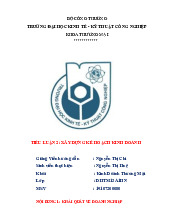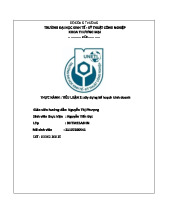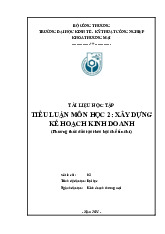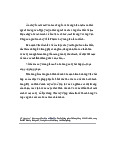









Preview text:
ISSN 1644-0757 eISSN 2450-4602 http://acta_oeconomia.sggw.pl
Oeconomia 15 (4) 2016, 117–126
BRANDING AND REBRANDING – GROCERY MARKET PERSPECTIVE Barbara Mróz-Gorgoń
WrocBaw University of Economics
Abstract. The paper presents problems of branding and rebranding as strategies of brand
image creation. The study focused on grocery market as an example. The article aims to
analyze branding activities of the grocery market and to identify trends, as wel as the rea-
sons for rebranding actions and tactics. Brands host many qualities, some of them
spiritual (i.e. values, mission) or virtual (i.e. logo). A change of image is one of the ways to
regain or keep competitive advantage. Effective rebranding activities – those positively
influencing brand image – must distinguish a brand from competition, increase brand
awareness and be conform to company mission and strategy. The article is based on
studies of national and foreign literature, as wel as on results of authors’ own primary
studies (questionnaire and focus group interview).
Key words: branding, rebranding, brand image, brand identity, grocery market INTRODUCTION
The everyday complexity for firms in an international environment is that marke-ters
struggle with branding and the establishment of brands. Various questions are raised
within this area, regarding building brands in the most effective way? [Kel er 2003].
“Brand” can be defined as the name, design (shapes, colours, sounds etc.), logo, symbol, or
any other characteristics or attributes that distinguish one company’s product or service from
those of other companies [Ghodeswar 2008]. Brands are composed of intangible elements related
to their specific promise, personality, and positioning and tangible com-ponents with identifiable
representation including logos, Figureics, colours and sounds. A brand creates perceived value
for consumers through its personality in a way that makes it stand out from other similar products.
Its story is intricately intertwined with the public’s perception and consistently provides consumers
with a sense of security, of knowing
Corresponding author: Barbara Mróz-Gorgoń, WrocBaw University of Economics, Faculty
of Eco-nomics Sciences, Institute of Marketing, Komandorska 118/120, bud. O, 53-345
WrocBaw, e-mail: barbara.mroz-gorgon@ue.wroc.pl
© Copyright by Warsaw University of Life Sciences Press, Warsaw 2016 118 B. Mróz-Gorgoń
what they’re paying for. In a world where every individual is also a media entity, your consumers
own your brand (as it always was) [Cohen 2011]. In common understanding, brands are symbolic,
shorthand marketing messages creating emotional bonds with trades and, in a context of
competitors comparison, an emblem to print in customers’ memory.
Stil , there are few studies concerning branding on grocery market. Some studies fo-
cus on use of foreign language in branding. For example, F. Leclerc, B.H. Schmitt and L.
Dubẻ had investigated how French and English brands names affect consumer evalua-
tion of brands and products. The authors used brand names that can be pronounced in
ei-ther French or English. They found that when the name was pronounced in French
rather than English, attitudes toward the brand were significantly more positive for
hedonic products. For utilitarian and so cal ed hybrid products brand attitude did not differ
with pronunciation [Leclerc et al. 1994].
Most authors focus their attention on multiple roles of branding in international mar-
keting [Leclerc et al. 1994, Wong and Merrilees 2007, De Mooij and Hofstede 2010], on
the role of particular branding elements, like the role of a salesperson in branding
process, brand loyalty creation, and Business-to-Business branding [Lynch and de Cher-
natony 2007, Chernatony et al. 2011], or on branding performance, communication and
corporate branding [Harris and de Chernatony 2001, Rubinstein 2002, Knox and
Bickerton 2003, Balmer and Greyser 2009]. There are also studies on non-profit branding
[Stride 2006, Daw et al. 2011] and branding in different sectors, such as: place (city and
region) branding [Kavaratzis 2004, Van Ham 2008, Govers 2009, Auczak 2011], fashion
and luxury goods branding [Okonkowo et al. 2007].
As L. de Chernatony, M. McDoald and E. Wal ace pointed out, powerful branding
theories are not just wel grounded, but are also easily applied in a variety of situations
[Chernatony et al. 2011]. Effective branding may lead to improved customer loyalty, lar-
ger number of orders, better sale volume, and higher revenue and profits. There are
diver-se branding strategies, including company names, individual branding, attitude
branding, private labels and social media brands. Increasing brand awareness is vital to
the survival and success of most businesses [Schuliang and Jin Zeng 2014]. A brand can
be seen as a promise of a package of attributes, which a person buys and which leads to
satisfaction. The attributes which create a brand can be il usory or real, emotional or
rational, invisible and tangible [Ambler and Styles 1996]. Being understood as major parts
of al brands, changing these would be considered as a vital event.
Referring to the PMR report Grocery retail in Poland 2012. Market analysis and deve-lopment
forecasts for 2013–2015 in December 2012, the grocery market in Poland reached the value of
over 230 bil ion PLN (54.9 bil ion EUR), 2.5% more than previous year (in methodology, the value
of the grocery market covers the value of al products sold in gro-cery stores, including non-food
range, as wel as food items purchased through other distri-bution channels). According to PMR’s
initial estimates for 2012, there are already nearly 80 discount stores per one mil ion Poles, their
share reaching 17%. Over the last five years their number has surged by almost 80%, to nearly 3
thousand outlets, with their market share doubling in the same period. In the medium term the
discount segment wil remain the market leader as regards the growth rate. Forecasts indicate
that in three years there wil be about 4 thousand discount stores in Poland, or over 100 per one
mil ion Poles, and by then they might account for already nearly a quarter of the grocery market. Acta Sci. Pol.
Branding and rebranding – grocery market perspective 119
The grocery retail sector in Poland is changing as a result of economic and demoFi-
gureic factors, trends and an ever-increasing number of influences. Grocery producers,
processors and distributors, as wel as companies that support the retail industry with
products, services and technology are interested in the prognosis for Poland’s economic
recovery and expansion and the results that recovery wil produce for grocery retail cha-
ins, franchises and other retailers [Wood 2013].The market’s rapid evolution, as wel as
its value justify, therefore, studies of the rebranding process. BRANDING AND REBRANDING
Product branding focuses on individual product’s identity and value [Ghodeswar
2008]. Researchers and practitioners both realized that brands, same as humans, have
specific personalities which might make them different in customer minds [Roustasekeh-
ravani and Hamid 2014]. Most firms attempt to measure satisfaction and loyalty for their
brand, because customer loyalty is a vital indicator whether a product is successful or
not. However, they do not think about vital factors that build satisfaction and loyalty. A
major problem with this kind of effort is that measuring satisfaction and loyalty does not
show how to build it. One of essential strategies to build satisfaction and loyalty in
branding strategy is brand personality [Roustasekehravani and Hamid 2014].
There are many theories about the way consumers buy brands, and debate stil
contin-ues about their respective strengths and weaknesses. For example, some argue
that brand choice can be explained by what is known as the expectancy-value model. In
this model, it is argued that consumers intuitively assign scores to two variables, one
being the degree to which they expect a pleasurable outcome, the other being the value
they ascribe to a favourable outcome. When faced with competing brands, this model
postulates that consumers assign scores to these expectancy-value parameters and,
fol owing an informal mental calculation, make a selection based on the highest overal
score [Chernatony et al. 2011]. As P. Doyle pointed out, having a successful brand wil
result in a bigger market share and more profitability [Doyle 1989]. Brands need to evolve
and adapt to dynamic competition, consumer expectations, and environmental changes.
Marketing efforts and advertising campaigns should be made by companies to build
positive perceptions for their corporate and product brands and thus to achieve better
sales and profit margins than competitors [Schuliang and Jin Zeng 2014].
Brand awareness and recognisability is related to the consumers’ ability to confirm
they have had contact with a brand before upon hearing its name. Spontaneous recal of
a brand is a situation in which consumers can think of a given brand on their own upon
hearing of a category of products and the needs they satisfy. Branding is, therefore, a
con-tinuous and complex process which creates brand identity through ascribing given
traits and attributes to it, thus building brand awareness and image.
Rebranding is not only changing the visual, Figureical image (though this is the most
common approach to rebranding), but a series of decisions related to broader aspects of
brand perception. Many companies, especial y big firms and global corporations operat-
ing as franchise systems, have regularly rebranded their outlets by changing one, some
or many elements of their activity and image. Looking at the list of the world’s 100 biggest
franchises in 2015, fast food brands dominate the list [Franchise Direct 2015]. Oeconomia 15 (4) 2016 120 B. Mróz-Gorgoń
For example, McDonald’s and Burger King had no indoor dining til the 1960s – and
that was part of their strategy.Their strategy was also strongly focused, referring to the R.
Lauterborn 4 C’s Concept [Lauterborn 1990], on convenience and therefore, adapting to
new consumer trends, they have shifted towards indoor dining. As A.F. Smith pointed
out, most companies require their franchisees to change their design every few years.
When McDonald’s shifted from the original red-and-white-tile drive-in design to a brick
build-ing with indoor sitting, the change increased sales by more than 50%. Adding drive-
thrus a few years later brought similar results. Rebranding occasional y meant attracting
new target audiences, such as children, those interested in eating a fast food breakfast,
or those who wanted more nutritious meals. Today, chains are adding new technology,
new equip-ment, new products, and new architectural designs. Constant rebranding
keeps up the company’s image and tel s customers that there’s always something new
and innovative about the chain [Smith 2012]. The study suggests that, although
periodically redesigning a brand logo is a pre-requisite to guarding one’s position in
consumers’ consideration set, drastic changes require more time to process, especial y
from highly brand conscious consumers (deeper levels of attention), and their attitude
towards the brand becomes more negative [Verlregh et al. 2015].
As is the case of marketing, where there is not a single mode of action
accurate al-ways and for al enterprises, there is no single effective course of
action in branding, no universal strategy to successful y communicate and market
a brand.In business practice, rebranding is one of the ways of reacting to
deteriorating or bad brand image: resurrecting it in consumer awareness. Several
phenomena may justify rebranding strategies, such as [KBosiński 2015]: •
customers having no emotional connotations with the brand, •
new fashions and customer trends, •
customers considering a brand untrustworthy, • mergers or takeovers.
Another motive for rebranding can be an attempt at changing or erasing some stere-
otypes associated with a brand or company [Borbis Media 2015] Rebranding is a process
of creating new image of a product, service or organisation in an attempt at distinguishing
this image and its associations from the competition in the customer perception. Suc-
cessful rebranding should distinguish a brand from the competition and be conform to
company mission and strategy [Danilewicz 2015]. METHOD
The theoretical part was based on literature review, and the fol owing research ques-tions have been posed: •
How is the grocery market perceived in Poland? •
What is the image of grocery market brands and what elements are coded for this category? •
Do rebranding activities influence the image of chosen brands on said market, and if so, how? Acta Sci. Pol.
Branding and rebranding – grocery market perspective 121
Answering these questions was done through primary studies. Quantitative research
through online questionnaire has been made via the ankietka.pl website in October and
November 2015. Exactly 148 answers were received, though 131 questionnaires were
qualified for analysis. The majority of the respondents had university education (44%
having a master degree and 12% finished postgraduate courses), lived in large cities
(25% living in cities up to 500 thousand inhabitants, and 58% in cities with over 500 tho-
usand inhabitants) and were aged 18-65, with age proportions being: 18–24 (32%), 25–
34 (37%), 35–44 (23%), 73% were women, 27% were men.
Qualitative research, in the form of focus interviews, was conducted between
12th and 15th October in two groups eight participants each. The participants
were students of two col eges of WrocBaw (aged 20–24). They were not
previously acquainted. During the interviews they were shown materials related to
grocery market brands (brands of certain grocery stores and foodstuff
manufacturers) which had undergone rebranding processes, and they were asked
about their feelings and opinions on those brands and changes in their image.
Analysis of literature and own results also al owed to formulate several
hypotheses, which have been presented in the summary of this article. FINDINGS
Grocery stores offer an inclusive variety of food products, household goods
and me-dicinal products to local areas. According to a survey conducted by
Information Resour-ces Inc., 52% of shoppers choose a grocery store to shop in
based on the lowest prices on the items they’re looking for [Legler 2014].
Respondents were asked to list the qualities they take into account when buying gro-
ceries, and to point out the qualities they considered the most important. The large ma-
jority (70%) agreed that the country of origin was the least important aspect of grocery
products. The four most important qualities were, from the top: the price, the brand,
expiration date and packaging esthetics. Vast majority of respondents agreed that it was
important for a product to be of Polish make (as seen on Fig. 1). 20% Yes 33% Rather Yes 9% No 5% Rather not 33% Neither yes nor no
Fig. 1. Is it important for you that the food product is of Polish origin?
Source: Based on author’s own research. Oeconomia 15 (4) 2016 122 B. Mróz-Gorgoń
Respondents were also asked to determine for which kinds of food products
the brand mattered most or least (where 1 mattered most and 9 mattered least),
and the majority stated that the brand was most important in meat and cold cuts
products. Figure 2 shows the results of this evaluation in detail. Fruits and vegetables Spices Prepara ons Bread Beverages Alcohol Candy Dairy Butchery 0,00 1,00 2,00 3,00 4,00 5,00 6,00 7,00 8,00 9,00 10,00 The average posi on Fig 2.
What categories of foods is of the most importance for you, and which the least?
Source: Based on author’s own research.
In answer to questions about foodstuff advertisements (where a maximum of three
responses could be chosen), respondents replied that they should be factual (73%) and
show the product’s history (52%). Figure 3 shows the responses in detail. 80,00% 70,00% 60,00% 50,00% 40,00% 30,00% 20,00% 10,00% 0,00% Happy
Factual Elegant Tells the story Family Celebrity use of the product
Fig. 3. What should be a good advertisement of food products?
Source: Based on author’s own research.
These results were confirmed in qualitative research: respondents said that grocery
advertisements should be “modern and contain elements of storytel ing” and “have high
esthetical quality”. During focus interviews, respondents noticed an important, positive Acta Sci. Pol.
Branding and rebranding – grocery market perspective 123
influence of TV shows on cooking and healthy eating on the grocery market (it should be
noted here that 71% respondents said information on environmental and ecological
properties of the product was important for them). This is reflected in rebranding projects.
Two examples were studied, that of the Lidl discount chain and Roleski, manufacturers of
mustard, mayonnaise and ketchup. Both cases were evaluated positively: respondents
claimed Lidl helps to inform the public on healthy eating, and Roleski managed to create
a brand identity for itself. All members of the focus group said they were not aware of the
brand’s existence before their rebranding projects, despite the fact that Roleski was the
first company in Poland to obtain a concession to produce mayonnaise in 1972. CONCLUSIONS
The core idea of branding process is brand identity – the ways in which brand archi-
tects create brand personality and how they want the clients to perceive it. In a narrow
sense, the meaning of branding is to create specific brand image in consumers’ minds.
This definition limits the branding process to creating a product, brand or service, and to
activities introducing the brand to the market. In a broader sense, branding is a process
connected to marketing strategy, which aims to create and strengthen the positive image
of a particular brand. Brand personality plays a crucial role in the branding process.
Rebranding, or “creating brand again”, can be divided into active and reactive phenom-enona,
as this difficult process is usual y performed for two main reasons. The first is an active desire to
change the brand image by distancing it from the past, unattractive image or to communicate new
features to consumers. The second reason is a consequence of brand ownership change, mostly
through a takeover or merger, which natural y force changes.
Our research has shown that Polish consumers are aware of brand importance on the
grocery market: it is of equal importance to product price to them. Consumers expect fac-
tual information, but also – since they fol ow modern consumer trends – they appreciate
and expect the brand’s story (storytel ing advertisements). Important qualities in grocery
market branding are family and humour. Esthetics and educational aspects of branding
(environmental information) have also been pointed out as important, and respondents
have shown themselves to be supportive of ethnocentric consumer attitude.
Rebranding is a process of creating new image and reception of a brand,
product, service or organization, in an effort to distinguish this image and its
associations from the competition. Rebranding process may concern changes in
the logo, name, packaging, marketing communication, or category code (for
example changing the color scheme used in the entire category). Effective
rebranding should distinguish a brand from the competition.
Basing on the analysis performed, the authors formed the fol owing hypotheses: •
H1 – there are certain specific traits ascribed to a grocery brand which can
positively influence its reception. •
H2 – rebranding on the grocery market can have significant influence on
repositioning the brand in the long term. •
H3 – the so-cal ed consumer trends have a significant influence on rebranding
proces-ses on the grocery market. Oeconomia 15 (4) 2016 124 B. Mróz-Gorgoń •
H4 – rebranding the leader of a given section of the market has a positive
influence on the image of the whole section. •
H5 – rebranding has a positive influence on customer loyalty in the long term. •
The authors intend to verify these hypotheses in the course of further original rese-arch. REFERENCES
Ambler, T., Styles, C. (1996). Brand development versus new product development: towards a
process model of extension decisions. Marketing Intel igence & Planning, 14 (7).
Balmer, J.M.T., Greyser, S.A. (2006). Corporate marketing: Integrating corporate identity,
corpo-rate branding, corporate communications, corporate image and corporate
reputation. Eu-ropean Journal of Marketing, 40, 7/8.
Borbis Media (2015). Rebranding, czyli o od\wie|aniu marki. Retrieved from http://www.borbis.
pl/blog/rebranding-czyli-o-odswiezaniu-marki (accessed: 13.10.2015).
Chevalier, M., Mazzalovo, G. (2012). Luxury Brand Management: A World of Privilege.
2nd Edi-tion, Wiley & Sons, Singapore.
Chernatony, L., de McDoald, M., Wal ace, E. (2011). Creating Powerful Brands. Fourth Edition, Elsvier, Oxford.
Cohen, H. (2011). 30 Branding Definitions. Retrieved from http://heidicohen.com/30- branding-definitions.
Danilewicz, J. (2015). Kiedy nale|y przeprowadzić rebranding. Retrieved from http://bizrun.pl/
marketing/kiedy-nalezy-przeprowadzic-rebranding (accessed: 09.10.2015).
Daw, J.S., Cone, C., Merenda, K.D., Erthard, A. (2011). Breakthrough Nonprofit Branding: Seven
Principles to Power Extraordinary Results. John Wiley & Sons, New Jersey.
De Mooij, M., Hofstede, G. (2010). The Hofstede Model: Aplications to Global Branding and Ad-
vertising Strategy and Research. International Journal of Advertising, 29 (1).
Doyle, P. (1989). Building successful brands: the strategic options. Journal of Marketing Manage-ment, 5 (1),
Franchise Direct (2015). Top 100 Global Franchises – Rankings. Retrieved from
http://www.fran-chisedirect.com/top100globalfranchises/rankings.
Ghodeswar, B.M. (2008). Building brand identity in competitive markets: a conceptual
model, Journal of Product & Brand Management, 17, 1.
Govers, R., Go, F. (2009). Place branding. Glocal, virtual and physical identities,
constructed, im-agined and experienced. Polgrave Macmil an, New York.
Harris, F., de Chernatony L. (2001). Corporate branding and corporate brand
performance. Euro-pean Journal of Marketing, 35, 3/4.
Kavaratzis, M. (2004). From city marketing to city branding: Towards a theoretical
framework for developing city brands. Place Branding, 1, 1.
Kel er, K.L. (2003). Brand synthesis: the multidimensionality of brand knowledge. Journal of Con-sumer Research, 29 (4).
KBosiński, J. (2015). Jak przeprowadzić rebranding? Stowarzyszenie Twórców Grafiki U|
ytkowej. Retrieved from http://stgu.pl/art-teksty/art-jak-przeprowadzic-
rebranding.html (accessed: 12.10.2015).
Knox, S., Bickerton D. (2003). The six conventions of corporate branding. European Journal of Marketing, 37, 7/8. Acta Sci. Pol.
Branding and rebranding – grocery market perspective 125
Lauterborn, B. (1990). New Marketing Litany: Four Ps Passé: C-Words Take Over. Advertising Age, 61 (41).
Leclerc, F., Schmitt, B.H., Dubẻ, L. (1994). Foreign Branding and Its Effects in Effects on
Product Perceptions and attitudes. Journal of Marketing Research, 31, 2.
Legler, D. (2014). 4 Unique Ways to Improve your Grocery Store Marketing, Go Digital,
Retrieved from http://www.godigitalmarketing.com/4-unique-ways-improve- grocery-store-market-ing.
Li, S., Li, J.Z. (2014). Web & social media dynamics, and evolutionary and adaptive
branding: theories and a hybrid intel igent model. Proceedings of the 13th
International Conference on Artificial Intel igence, Knowledge Engineering and
Data Bases (AIKED ’14): Ad-vances in Neural Networks, Fuzzy Systems and
Artificial Intel igence, 15–17 May 2014, Gdansk, Poland.
Lynch, J., Chernatnatony, L. (2007). Winning Hearts and Minds: Business-to-Business Branding
and the role of the Salesperson. Journal of Marketing Management, 23 (1–2).
Auczak, M. (2011). Branding miejsca turystycznego na przykBadzie Gdańska. Zeszyty
Naukowe Uniwersytetu Szczecińskiego, 663, Ekonomiczne Problemy UsBug 75.
Okonkwo, U. (2007). Luxury Fashion Branding: Trends, Tactics, Techniques. 1st Edition. Palgrave Macmil an, New York.
PMR (2012). Report: Grocery retail in Poland 2012. Market analysis and development forecasts for 2013–2015. Retrieved from
https://www.pmrpublications.com/press-releases/380/gro-cery-market-in-poland-worth- nearly-55bn-in-2012.
Roustasekehravani, A., Hamid, A.B.A. (2014). Do Brand Personality Real y Enhance
Satisfac-tion and Loyalty Toward Brand? A Review of Theory and Empirical
Research. European Journal of Business and Management, 6, 25.
Rubinstein, H. (2002). Branding on the Internet — Moving from a communications to a
relation-shipapproach to branding. Interactive Marketing, 4, 1, 1.
Smith, A.F. (2012). Fast Food and Junk Food: an encyclopedia of what we love to eat. Greenwood, California.
Stride, H. (2006). An Investigation into the Values Dimensions of Branding: Implicationsfor
the Charity Sector, A Brand New World for Nonprofits. International Journal of
Nonprofit and Voluntary Sector Marketing, 11, 2.
Van Ham, P. (2008). Place branding: The State of the Art. The Annals of the American
Academy of Political and Social Science, 616 (1).
Verlregh, P., Voorveld, H., Eisend, M. (Eds) (2015). Advances in Advertising Research (Vol. 6):
The Digital, the Classic, the Subtle, and the Alternative. Springer, Wiesbaden.
Wong, H.Y., Merrilees, B. (2007). Multiple roles of Branding in International Marketing.
Interna-tional Marketing Review, 24 (4).
Wood, L. (2013). Research and Markets: Grocery Retail in Poland 2013, Reuters.
Retrieved from http://www.reuters.com/article/2013/10/15/research-and-markets
idUSnBw155862a+10 0+BSW20131015#590zc0wQxMIb8Ixr.97.
BRANDING I REBRANDING NA PRZYKAADZIE RYNKU SPO{YWCZEGO
Streszczenie: ArtykuB przedstawia problematykę związaną z procesem brandingu i rebran-dingu
jako strategi kreowania wizerunku marki na przykBadzie rynku spo|ywczego. Celem artykuBu jest
analiza dziaBań brandingowych na rynku spo|ywczym oraz identyfikacja po- Oeconomia 15 (4) 2016 126 B. Mróz-Gorgoń
wodów podjęcia się okre\lonych dziaBań i taktyk rebrandingu. Marka jest uciele\nieniem
wielu atrybutów, niektóre z nich są duchowe (jak np. warto\ć, misja), inne wizualne (jak
np. logo). Zmiana wizerunku jest jednym ze sposobów podtrzymywania lub pozyskiwa-nia
przewagi konkurencyjnej. Efektywne dziaBania rebrandingowe – te, które pozytywnie
wpBywają na wizerunek marki – powinny odró|nić markę na tle konkurencji, powodować
wzrost \wiadomo\ci marki i być spójne z misją i ze strategią marki. ArtykuB opracowano
na podstawie studium literatury krajowej i zagranicznej oraz wyników badań wBasnych o
charakterze pierwotnym (badanie ankietowe oraz grupy focusowe).
SBowa kluczowe: branding, rebranding, wizerunek marki, to|samo\ci marki, rynek spo-|ywczy Accepted for print: 26.10.2016
For citation: Mróz-Gorgoń B. (2016). Branding and rebranding – grocery market perspective.
Acta Sci. Pol., Oeconomia, 15 (4), 117–126. Acta Sci. Pol.




